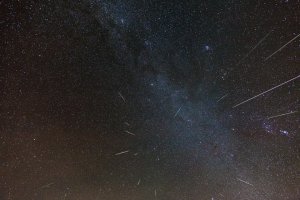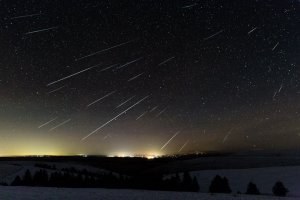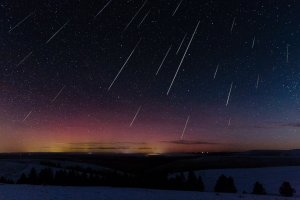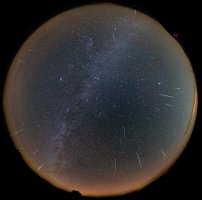To all,
Here are four Geminid Meteor Shower composites I created from two nights of imaging. They were taken on the nights of December 13th and 14th. I took approximately 5500 images using four cameras. I used two 5D2, one 5D3, and one 1DX. I rented the 5D3 and a Zeiss Distagon 15mm f/2.8 lens.
The first composite was created from 18 images. Each image was a 60 second exposure at ISO 3200 unguided on a German equatorial mount. The camera was an unmodified Canon 5D2 with a Canon 14mm f/2.8L lens stopped down to f/4.0. Each individual image was processed in Lightroom. The composite was done in Photoshop CC.
The second composite was created from 24 images. Each image was 20 or 25 seconds at ISO 5000 on a fixed tripod. The camera was an unmodified Canon 5D3 with a Canon TS-E 17mm f/4.0L lens stopped down to f/4.5. Each individual image was processed in Lightroom. The composite was done in Photoshop CC.
The third composite was created from 18 images. Each image was 20 or 25 seconds at ISO 5000 on a fixed tripod. The camera was an unmodified Canon 5D3 with a Canon TS-E 17mm f/4.0L lens stopped down to f/4.5. Each individual image was processed in Lightroom. The composite was done in Photoshop CC. There was a very faint aurora that began just after moonrise. I could not see it visually, but the camera easily picked it up. Since the underlying image was taken after moonrise and later in the night, I had to remove some of the meteors from the second composite since they were outside the field of view; however, I was also able to add a few new ones.
The final composite was created from 30 images. Each image was 30 seconds at ISO 6400 on a fixed tripod. The camera was a Canon 1DX using a Canon 8-15mm f/4.0L lens at approximately 8.5mm with an aperture set to wide-open. Each individual image was processed in Lightroom. The composite was done in Photoshop CC. The crescent Moon had just risen, illuminating the underside of the cloud feature in the east. The shadowed feature at the bottom is a bird house.
Thanks for looking,
Wade
Here are four Geminid Meteor Shower composites I created from two nights of imaging. They were taken on the nights of December 13th and 14th. I took approximately 5500 images using four cameras. I used two 5D2, one 5D3, and one 1DX. I rented the 5D3 and a Zeiss Distagon 15mm f/2.8 lens.
The first composite was created from 18 images. Each image was a 60 second exposure at ISO 3200 unguided on a German equatorial mount. The camera was an unmodified Canon 5D2 with a Canon 14mm f/2.8L lens stopped down to f/4.0. Each individual image was processed in Lightroom. The composite was done in Photoshop CC.
The second composite was created from 24 images. Each image was 20 or 25 seconds at ISO 5000 on a fixed tripod. The camera was an unmodified Canon 5D3 with a Canon TS-E 17mm f/4.0L lens stopped down to f/4.5. Each individual image was processed in Lightroom. The composite was done in Photoshop CC.
The third composite was created from 18 images. Each image was 20 or 25 seconds at ISO 5000 on a fixed tripod. The camera was an unmodified Canon 5D3 with a Canon TS-E 17mm f/4.0L lens stopped down to f/4.5. Each individual image was processed in Lightroom. The composite was done in Photoshop CC. There was a very faint aurora that began just after moonrise. I could not see it visually, but the camera easily picked it up. Since the underlying image was taken after moonrise and later in the night, I had to remove some of the meteors from the second composite since they were outside the field of view; however, I was also able to add a few new ones.
The final composite was created from 30 images. Each image was 30 seconds at ISO 6400 on a fixed tripod. The camera was a Canon 1DX using a Canon 8-15mm f/4.0L lens at approximately 8.5mm with an aperture set to wide-open. Each individual image was processed in Lightroom. The composite was done in Photoshop CC. The crescent Moon had just risen, illuminating the underside of the cloud feature in the east. The shadowed feature at the bottom is a bird house.
Thanks for looking,
Wade




